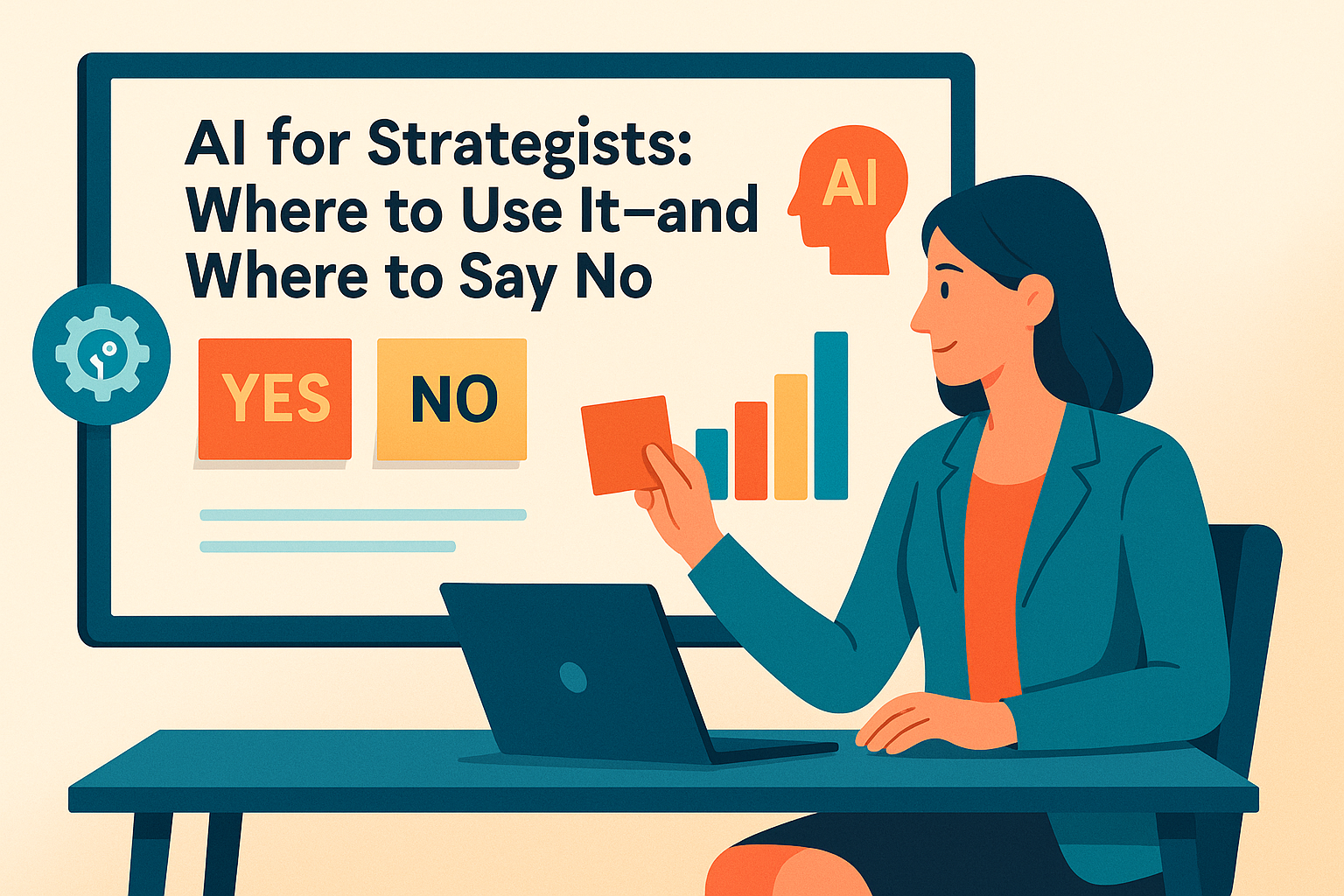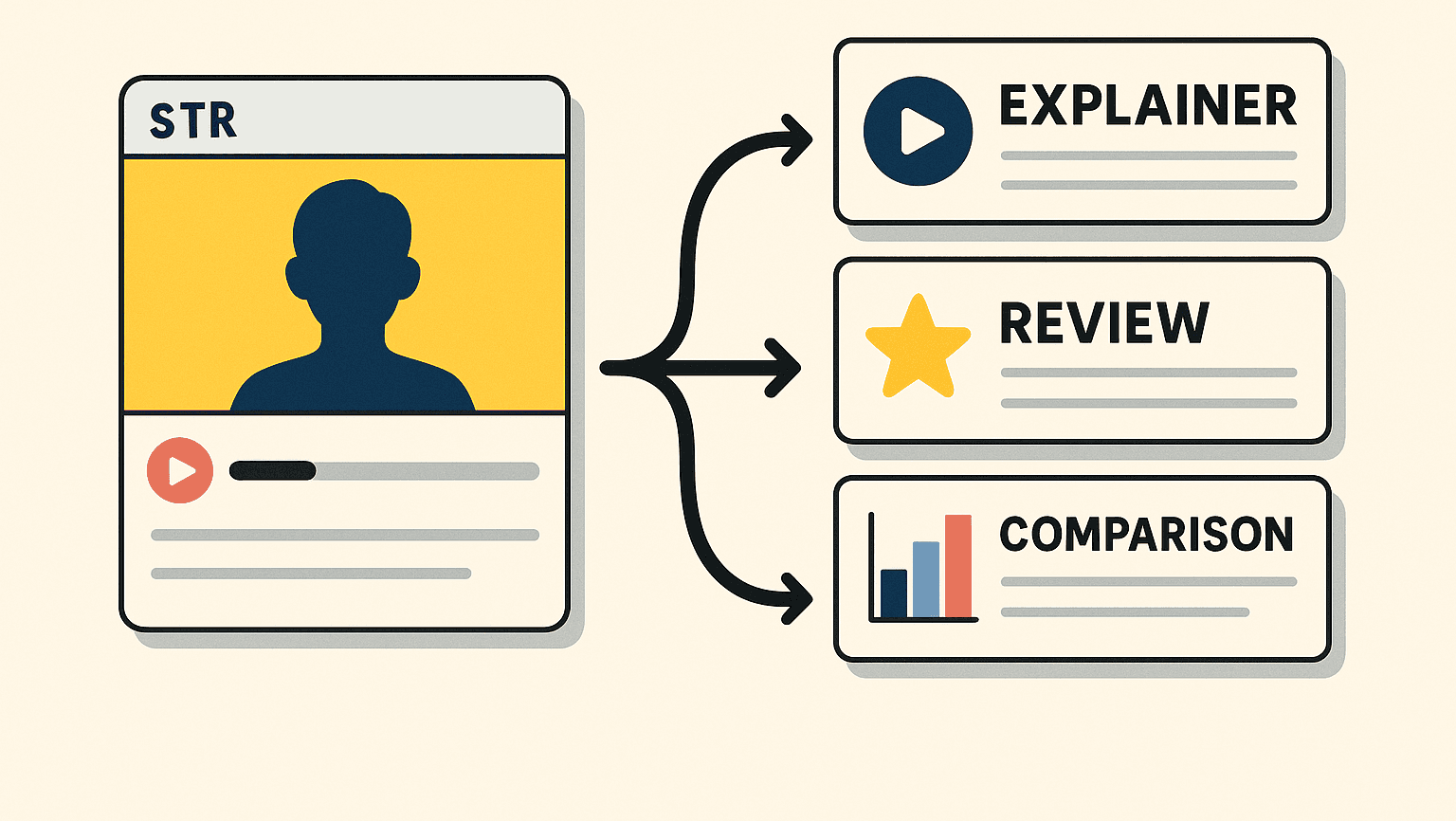AI for Strategists: Where to Use It—and Where to Say No

AI for Strategists: Where to Use It—and Where to Say No
TL;DR
Use AI to scale work, not decide direction.
AI is an amplifier of execution, not an architect of intent. Let it expand your creative options, summarize research, and speed production—while humans set the goal, choose the proof, and own the final call. When teams confuse speed with strategy, they ship more of the wrong thing faster.
Guardrails matter.
Models predict plausible text or images; they don’t understand consequences. That’s why brand safety, claims accuracy, and tone must pass through human review. A lean human-in-the-loop (HITL) step is not red tape—it’s how you protect margin and reputation at scale.
Test before trusting.
Treat every AI suggestion as a hypothesis. Use experiments and lift-based reads to decide what wins, whether the idea came from a person or a model. Data separates novelty from impact, guiding where to double down and what to drop.
Why this matters now
Marketers are in a paradox. The tools have never been faster, but attention has never been scarcer. AI can generate five landing pages and fifty ad variants in minutes; none of that matters if the message doesn’t connect with a human need. McKinsey, BCG, and Think with Google all converge on the same finding: the highest ROI comes from augmentation, not automation—machines handle throughput, people handle meaning.
The risk is subtle but expensive: strategy drift. When production velocity surges, teams can start letting tools define the work. Briefs get vague (“let’s see what the model comes up with”), weak claims slip into copy, and complex choices—pricing, positioning, promise—quietly defer to the default. As Avinash Kaushik reminds us, data tells you what happened; strategy tells you what to do next. AI is powerful, but it doesn’t care. You have to.
The opportunity is equally real. Used well, AI cuts the “tax” on strategy: synthesizing research, producing baseline variants, and structuring messy inputs so humans can think. Neil Patel’s playbooks echo this—let AI remove drudgery, then invest your saved time in better briefs, sharper offers, and clearer proof. That’s where conversion moves.
What to do this month (a strategist’s playbook)
1) Put AI where variability is high and risk is low.
Creative hooks, headlines, short-form scripts, and visual riffs are perfect candidates. Ask AI for 20 angles on one promise, then have a human shortlist the five that feel true to your brand. Constrain the model with a strong brief: audience, job-to-be-done, anxieties, and proof assets.
2) Keep humans in the high-judgment moments.
Claims, guarantees, pricing language, comparative assertions, medical or financial topics—these require human and legal review every time. Document a red/amber/green matrix so the team knows what can auto-ship, what needs spot checks, and what requires formal sign-off.
3) Design measurement into the workflow.
Don’t publish and pray. Pair every AI-assisted asset with an evaluation plan: primary metric (e.g., qualified leads, revenue per session), time window, and decision rule (ship, iterate, or kill). Favor incrementality tests and guard against last-click bias.
4) Build a reusable prompt + template library.
Prompts are just creative briefs in code. Store your top prompts for hooks, product pages, demo scripts, and FAQs in a shared repository. Include guidance on voice, banned phrases, and required proof points (ratings, specs, warranties). Version it like any other asset.
5) Instrument provenance and review.
Mark AI-assisted artifacts in your CMS and creative tracker. Record who reviewed what, when, and against which checklist. If an issue arises, you’ll know the chain of custody—and fix the process, not just the copy.
6) Train for judgment, not just tools.
Upskill teams on evidence-based marketing: what counts as proof, how to read lift, how to avoid spurious correlations. Tools change; judgment scales.
Where AI really helps (and what to watch)
Creative ideation and iteration.
Use AI to propose angles that humans wouldn’t think of, then filter aggressively. Watch for plausible-but-wrong claims and tone drift. Require sourceable proof for any strong assertion. Store winning hooks with their measured lift for reuse.
Research synthesis and sense-making.
Feed transcripts, survey results, reviews, and competitor copy into the model to cluster themes and extract patterns. Humans should write the insight sentence—the why behind the pattern—and propose actions. Avoid overfitting to noisy inputs or cherry-picked quotes.
Audience and keyword discovery.
Let AI suggest adjacent intents, long-tail phrases, and content outlines. Validate with real search data and performance history. Neil Patel’s SEO guidance is clear: ideas from models must be pressure-tested against demand and difficulty.
Ops and production plumbing.
Use AI for formatting, localization drafts, alt text, and image cutdowns. Keep a style checker in the loop to maintain voice. Build guardrails that block deployment if required metadata (claims, references, disclaimers) is missing.
Where to say no (for now)
Autonomous public posting.
Never allow unsupervised publishing on brand channels. A single off-tone or inaccurate message can erase the time you saved—and then some.
High-stakes claims and comparisons.
If the content could alter purchase decisions dramatically or invite regulatory or legal scrutiny, it must be written or strictly reviewed by humans with domain expertise.
Original brand voice and manifesto.
AI can help draft, but your brand’s core voice should be authored by humans. That voice is a strategic asset—protect it like one.
A lightweight HITL workflow you can copy
- Brief → Human writes a crisp brief (audience, job-to-be-done, promise, proof, constraints).
- Generate → AI produces variants (content or creative).
- Screen → Human triage for accuracy, tone, and risk (red/amber/green).
- Test → Deploy A/B or geo tests with clear metrics and time windows.
- Decide → Keep winners, retire losers, document learning.
- Systematize → Promote successful prompts, templates, and claims to your library.
This loop is fast enough to keep pace with performance needs and strict enough to protect the brand.
Pitfalls to avoid
- Volume without clarity. More assets are useless if your offer and proof are still vague. Fix the strategy before scaling content.
- Hallucinated authority. AI writes confidently even when wrong. Require citations or internal evidence before publishing claims.
- Review fatigue. Define checkpoints and empower approvers; otherwise, velocity creates bottlenecks.
- Metric myopia. Don’t optimize for clicks if you sell on confidence. Choose metrics that map to revenue or durable behavior change.
Mini case vignette (composite)
A mid-market SaaS brand used AI to produce 40 landing page headlines and five demo scripts in a week. Human reviewers killed half the headlines for weak claims, shipped four variants into an A/B test, and kept two winners that improved trial starts by 18%. The same team tried auto-generating customer stories; accuracy issues forced a rewrite. Lesson: AI shone in variant exploration, struggled in credibility-heavy narratives. Process beats enthusiasm.
FAQs & objections
Will AI replace strategists?
No. Strategy is choice under uncertainty. Models don’t choose; they predict. The strategist decides what not to do, which claims to make, and how to earn trust. AI can speed inputs, not judgment.
Is AI creativity “real”?
It’s combinatorial. Great for expanding possibilities, weak at inventing meaning. Use it to break blank-page syndrome; ship only ideas that pass your proof bar.
What’s the ROI case for human oversight?
Risk-adjusted math. One reputation event or compliance miss can cost more than a year of reviewers. Oversight preserves margin by preventing expensive mistakes.
How do I keep brand voice consistent across AI outputs?
Codify it. Provide a voice chart (do/don’t), banned phrases, and exemplar paragraphs. Enforce with checklists and a final human pass.
What’s the minimum viable stack to start?
A capable model, a prompt library, an approval checklist, and a testing plan. Add workflow and guardrail tools as volume grows.
The bigger picture
AI will not end strategy—it will expose it. When everyone can produce content at speed, the differentiator is clarity: a sharp promise, credible proof, and a humane voice that respects the customer. The most effective teams in 2025 will treat AI as a momentum engine and human judgment as the steering wheel. Keep that balance, and you’ll move faster and truer than competitors who automate the soul out of their marketing.
Read similar content
Similar topics

Creators as the New SEM: Build Searchable Trust, Not Just Impressions
When creators become media channels, brands win by making their content discoverable, trustworthy and measurable—not just viral.

Design for Stream→Search: Sequencing Content That Survives the Algorithm
Why brands need content ladders that move people from passive scrolling to active searching—and how to build sequences that compounding attention.

Where AI Actually Helps Your Customer Journey (And Where It Fails)
Variant generation, pre‑scoring attention, and budget routing—without propping up old funnels.